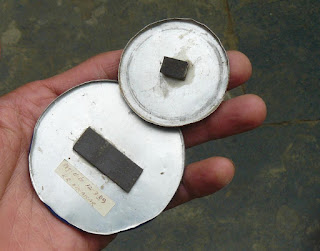Ting... ting... ding... ding... dong... tung..... I just love to hear those pleasing sounds. Old telephones had those melodiously sounding bells. How I miss them, even though we did not have it at home!
I had not known the name 'wind chime' in the early 1970s when I made my first wind chime. There was a tubular wind chime in someone's house that produced a most delightful melody. It must have been an imported one. I wondered if I got something that could 'ting', I could make such ones too, or so I had thought then!
We had bought some small bronze cymbals, more as toys than for using in the worship room. Two pairs, each attached with a string.
This was during our trip to Gokarna in 1969-70. These were found at odd places, carelessly neglected. It used to get entangled with other things and when they were taken out or fall down on the hard floor and make a pleasing 'ting'!
Since I wanted to make a wind chime myself from things that I had, lo, there was a 'ting' in my head! These cymbals were my first objects of my wind chime project. I had used all the four cymbals earlier - spacing was tricky. I had used a brass ring of an electric bulb holder [see in the pic below] to strike them. To catch the wind, I had hung the thin foil that was used to seal tins - in my case, it was a 'Bournvita' tin foil which I had cut up when opening it, neatly. I have since remodeled it and used only two and lost two, know not where and how.
I was at a shop in the market place two years ago when I found the sound from this wind chime [picture below] too pleasing. Just bought it!
Another one, but less pleasing. Poor buy. This is a somewhat a junk in itself. The thin tubes does not resonate well.
The 'U' you see here [below] is from a broken lock. It hangs free, on our main door frame. The bell is fixed to the door shutter. When the door is opened, it hits the 'u' and the bell 'tings'! We can hear this in the rooms. Just to know that someone is moving in or out of the door!
The broken leg of a century old writing desk became the handle of this bell. A bronze cup that was in the attic became the gong! It produces a beautiful sound. The writing desk was used by men sitting on the ground doing their work. They were in many homes. This desk was in poor shape with one of the four legs already missing and was in the attic.
.JPG)
Some brass cups [tumblers, as we call - picture below] were lying unused in the attic. If they are sold, we are not profited. So, I picked up the oval wooden board - which my grandfather made in his college days [1920] for his carpentry project! It was used by my grandmother for many years to roll chapaties. It was worn out, but still usable. I fixed these cups using screws after making holes. Hung rings from a small thread to strike the edges when the entire board is shaken. It is connected to a thread outside the main door. This becomes one of the 'calling bells'. Together, they make a good sound. This was inspired by my childhood memory I still carry of a particular pair of doors inside the Nanjangud Temple. When we visited there, I used to go and shake the doors [locked] and tens of bronze bells fixed to that trellis-like door produced a great sound. Children got lot of pleasure doing it, in those peaceful days. I still wonder why that small temple beside the main deity was locked. It had an idol inside.
.JPG)
Door curtain tubes were found useless when I replaced them with curtain springs. I wanted to make my own tube wind chime that resonated nicely. It worked! Steel pipes, chrome plated and rusted. Made small holes to hang them vertically. Wires used for hanging prevents vibrations, but thin thread has to be used to get the full vibrations. Nice wind chime! Disturbed my mother's sleep - it was in the yard. So had to shift it away.
Bicycle bells wind chime. Old junked bells, very old junked and rusted strainer [deep frying]. Bent the handle of this to hang. Used the existing holes to suitably space the hang of the bells. Each bell vibrates in a different frequency. This is also in the yard where there is good breeze. Steel links of a 'chain swing' I made 2 years ago strike the bells. The wind is picked up by a coconut shell and two plastic caps.
This is another of my favourite little calling bell at the main door. Pic below. A thread [actually a tennis racket gut] is left outside the door to pull. It is hung this way. I've used a piece of toy 'meccano' and stiff wire as 'axle'. This bronze bell - famous in the house as 'Dinu's bell - was my toy 50 years ago and produces a very pleasing sound. Its original handle had broken about 40 years ago. This handle-less bell was kept here and there! I made a handle, from a piece of aluminum tube and is now in good use as you can see below.

A few old computer printers had been junked at the workplace. I picked up the square rods from their paper feeding units. Using the tiny hole, I tried to ting by holding it with a pin. There was a very soft and pleasing 'ting' when I struck it. Slender cotton thread for hanging them gives best results as it does not absorb the vibrations. The striker is a steel ring I salvaged from a torn vanity bag. For catching wind, I have used a piece of balsa wood that is light weight. A long thread and heavier weight will make it oscillate more often.

One more wind chime I made from a spoiled 'ding-dong' electric bell. The plates are the ones that vibrate. I hung them with thread and put paper pieces to keep the hung threads above the hole away from the plate. If it touches, it affects the free vibration. I used a steel ring from a discarded vanity bag as striker. I have hung this ring in such a way that there is some imbalance which would make it oscillate more times. The wind catcher thread and the hung thread are tied on the same half of the ring. It produces pleasing 'tings'.
I'm fond of anything,
That will 'ting'.
~~~~~~~~~~~












.JPG)











.JPG)
.JPG)
.JPG)
.JPG)
.JPG)














.JPG)









.JPG)
